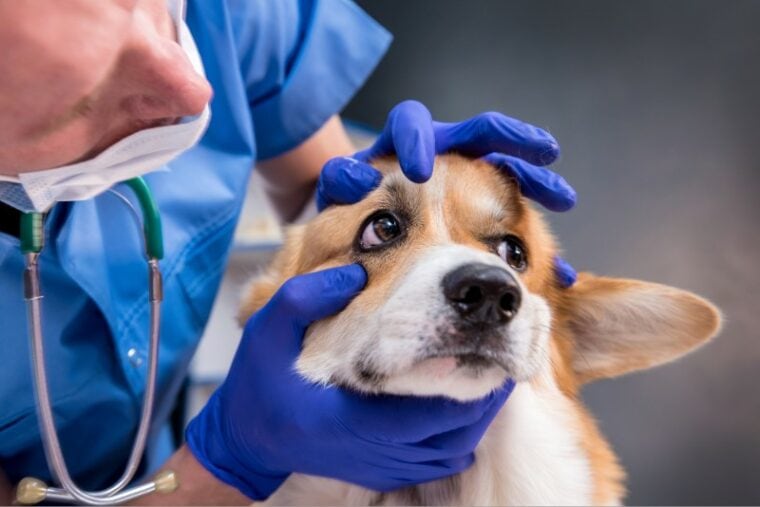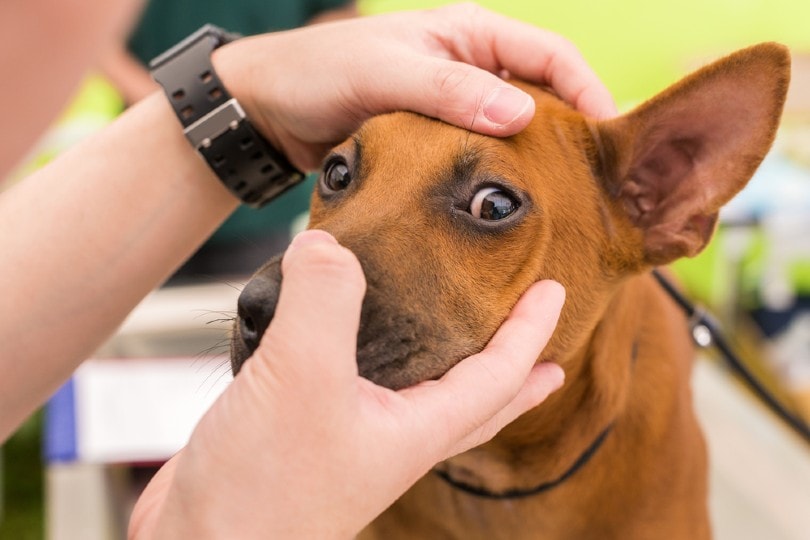
Click to Skip Ahead
The eyes can be susceptible to injury and disease just like the bladder, heart, or other organs of the body. When you think of an eyeball, you may not think about all of the structures that are inside the eye, or the globe itself. But there are a lot of working parts that go into making sure your dog can see normally. A fairly common disease of the eyes in a dog is uveitis, or inflammation of the uvea of the eye. This often results in the affected eye(s) having decreased pressure. Not sure what that is? Don’t worry. Keep reading to learn all about uveitis, what can cause it, and what types of treatments may be available for your dog.
What Is Uveitis?
The suffix “itis” means inflammation. Therefore, uveitis is inflammation of the uvea. This can include inflammation of one or multiple parts of the uvea. If all three parts (iris, choroid, ciliary body) are all inflamed, this is called panuveitis. Anterior uveitis is the term to describe inflammation of the ciliary body, and posterior uveitis is inflammation of the choroid.
As mentioned above, each eye is made up of many small parts. The back of the eye, essentially the lining of the back of the eyeball, is called the retina. The cornea is the surface of the eye that helps protect the rest of the globe from trauma and/or damage. The lens sits behind the cornea and iris, helping to direct and focus light to help produce the “images” that the brain recognizes through the eyes.
The uvea of the eye is made up of the iris (colored portion of the eye that controls pupil size), ciliary body (produces the fluid that fills the eye), and choroid (middle layer of the eye). The ciliary body produces what’s called the aqueous humor. This is the fluid that fills the eye to maintain a constant pressure, helps maintain the eye’s shape, and provides nutrients to other parts of the eye. The uvea of the eye also includes ligaments and muscles which help support the lens.

What Are the Signs of Uveitis?
The appearance of the eye(s) affected by uveitis can be difficult to see at first. The affected eye may have a constricted pupil, redness to the whites of the eye, squinting (otherwise known as blepharospasm), and a cloudiness to the eye. As uveitis progresses, the eye may start to bulge and/or become firm from glaucoma, and cataracts may develop.
If the cause of the uveitis is idiopathic, then there may be no other abnormalities aside from the above appearance of the eyes. If the uveitis is secondary to another underlying disease, then your dog may be lethargic, anorexic, have lost weight, have abnormal urinary and/or drinking behavior, and abnormal bloodwork changes.
What Are the Causes of Uveitis in a Dog?
There are many causes of uveitis. Oftentimes a cause is never found, and it’s then classified as idiopathic. Other common causes of uveitis include but are not limited to:
Often, both testing of the eyes and systemic testing (such as bloodwork and/or radiographs) are completed. This is because of the common occurrence of uveitis being secondary to another underlying disease. In other words, if your dog has a leptospirosis infection, that is a primary disease. A secondary disease would be the effects that leptospirosis has on the body such as the development of uveitis. Your veterinarian will want to get a good overall picture of your dog’s health by performing diagnostics to rule diseases in or out.

How Do I Care for a Dog With Uveitis?
If your dog has been diagnosed with uveitis, care should always be managed by a veterinarian. Online home remedies should never be tried as they may cause harm and even blindness. At minimum, your dog will need to be on eye drops, typically those that contain an anti-inflammatory, and sometimes an antibiotic as well. Sometimes more than one type of eye drop is needed to make the eye feel less uncomfortable for your dog.
If your dog has uveitis secondary to another disease, your veterinarian may prescribe your dog systemic antibiotics and anti-inflammatories as well. In other words, medications that are either injected or taken orally. These may be accompanied by immunosuppressive agents if your veterinarian suspects the uveitis is immune-mediated.
Your dog will need frequent rechecks with your veterinarian to have the pressures of the eyes monitored, and potentially bloodwork as well. Testing the pressure of the eyes requires specialized tools and needs to be completed by trained professionals. If your dog’s uveitis is difficult to manage, or develops complications, then your veterinarian may refer you to a Board Certified Veterinary Ophthalmologist to manage the condition.
Frequently Asked Questions (FAQ)
How Is Uveitis Diagnosed?
Uveitis has to be diagnosed by a veterinarian. Often, the pressure of the eye will be lower than normal in the affected eye(s). There are special tools, just like at your ophthalmologist, that are used to test the pressure of the eyes. Depending on what else is going on with your dog, full bloodwork is also completed to see if there are other disease processes going on.
Will My Dog Be Blind With Uveitis?
Just having uveitis will not cause blindness in your dog. However, if left untreated, or if treatment is unsuccessful, blindness can occur. With that said, depending on the cause of the uveitis, blindness may have occurred because of a trauma to the eye, cancer etc. Blindness is not necessarily from the uveitis, but from the cause of the uveitis.

Can Uveitis Be Cured?
Yes, depending on the cause. Uveitis can be successfully treated. Depending on what caused it in the first place, other underlying disease processes may or may not be able to be cured. For example, if your dog has uveitis because of cancer, the cancer may not be curable, but the effects on the eyes (i.e., the uveitis), may be curable.
Conclusion
Uveitis is classified as inflammation of one or multiple parts of the uvea of the eye. It can affect one or both eyes. Uveitis can be caused by another underlying disease such as a virus or bacterial infection, or no cause may be found, and it’s then classified as idiopathic. Diagnosing and treating uveitis should always be completed with a veterinarian, as home remedies may not only be ineffective but can also cause significant harm. Uveitis can be successfully treated and cured. However, if there is an underlying disease causing it, there may or may not be a cure, but it can hopefully be treated and managed.
Featured Image Credit: Roman Zaiets, Shutterstock







